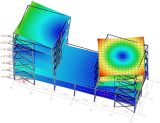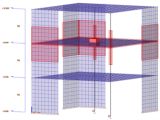Highlights
- Calculation of the structural vibration frequencies and associated modal shapes.
- Automatic calculation of the mass of the structure.
- Masses can also be manually entered as local or distributed or they can be derived from load in static calculations.
- The user sets the desired number of output modal values.
- For each modal value, the eigenfrequencies and eigen shapes will be calculated with the method selected by the user: Lanczos, Subspace, Polynomial.
- The results can be represented both numerically and graphically.
Modal analysis can be required to verify comfort criteria for buildings, to analyse wind-induced resonance for bridges, to check requirements for sensitive equipment, to understand the dynamic behaviour of the structure for seismic analysis purposes, etc...
Results of modal analysis include:
- Table output of eigen frequencies for each calculated natural mode
- Table output of mass participation factors according to each global direction (X, Y and Z).
- Graphical display of animated eigenmode shapes

IRS FOR MODAL ANALYSIS
When the aim is to perform a seismic assessment, modal analysis performed analysing the full mesh of the model will very probably return too much information about local vibrations, which are in fact irrelevant for the overall dynamic structural response.
The solution provided by the IRS method is to use a reduced mesh for the dynamic analysis. The Improved Reduced System (IRS) method automatically reduces both the stiffness and the mass matrix of the system.

This method has proven to give excellent results in dynamic analysis while calculation time is reduced tremendously and convergence to a large value of mobilized modal mass is quickly achieved.

Briefly, the advantages of using the IRS are:
- Vast reduction of computational time
- Elimination of local modes
- Easy to introduce accidental eccentricities
- Output of results per story

